Chapter 4
Comprehensive On-Site and Off-Site SEO Strategies for Lawyers
In the competitive and ever-evolving digital world of legal services, a robust combination of on-site and off-site SEO is indispensable for establishing and sustaining your law firm’s online presence. This chapter provides an in-depth guide to understanding and implementing on-site and off-site SEO strategies, offering a holistic approach to enhance your law firm’s digital footprint internally and externally.
Understanding the Synergy Between On-Site and Off-Site SEO
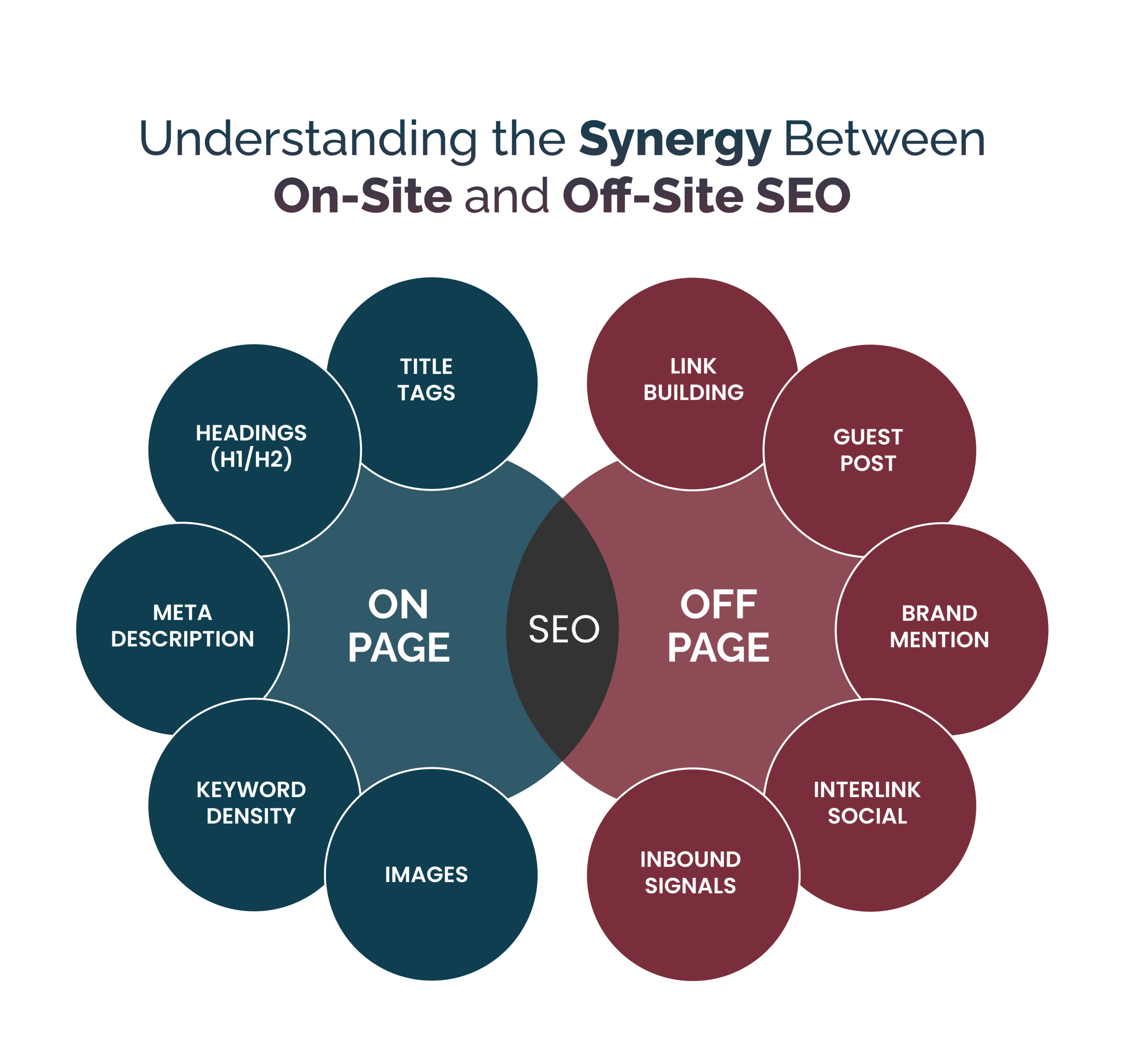
Before diving into the specifics, it’s crucial to grasp the importance and differences between on-site and off-site SEO.
On-site SEO, also known as on-page SEO for law firms, involves optimizations directly on your website to improve its visibility and ranking.
Off-site SEO, or off-page SEO, encompasses external efforts to boost your site’s credibility and authority.
Together, they form a cohesive strategy, complementing each other to enhance your overall SEO effectiveness.
In the competitive and ever-evolving digital world of legal services, a robust combination of on-site and off-site SEO is indispensable for establishing and sustaining your law firm’s online presence. This chapter provides an in-depth guide to understanding and implementing on-site and off-site SEO strategies, offering a holistic approach to enhance your law firm’s digital footprint internally and externally.
On-Site SEO: Crafting a Stellar User Experience
On-site SEO is your direct control over your website’s elements to make it more attractive to search engines and more engaging for visitors. It’s about fine-tuning the machinery under your website’s hood to ensure it runs smoothly and appeals to search engines and users. Here’s a closer look at the essential components and some added considerations:
Critical Elements of On-Site SEO
Visual Appearance
Beyond just aesthetics, the visual design of your site should align with your firm’s branding and ethos. Consider color psychology, imagery that reflects your practice areas, and layouts that guide the visitor’s eye to critical information. An intuitive and visually harmonious site can significantly increase user engagement and time spent on the page.
Site Structure
Understanding Site Structure
Effective site structure is crucial for both user experience and SEO, especially when targeting featured snippets and zero-click searches. It’s important to align your site’s layout with the way users phrase their queries. For multi-location firms, optimizing each location’s page for local SEO is essential, including clear Name, Address, Phone Number (NAP) details and localized content.
Two Main Structures
1. Hierarchical or “Deep” Structure:
- Description: In a hierarchical (tree or deep) structure, content cascades from general to specific categories, resembling a pyramid. It establishes a clear flow from broad topics to detailed subtopics.
- Example URL Structure:
- www.smithlawfirm.com/practice-areas/personal-injury
- www.smithlawfirm.com/practice-areas/personal-injury/car-accidentnts
- Pros: Enhances user understanding of content relationships and simplifies navigation.
- Cons: Can lead to more complex navigation paths, potentially increasing user effort.
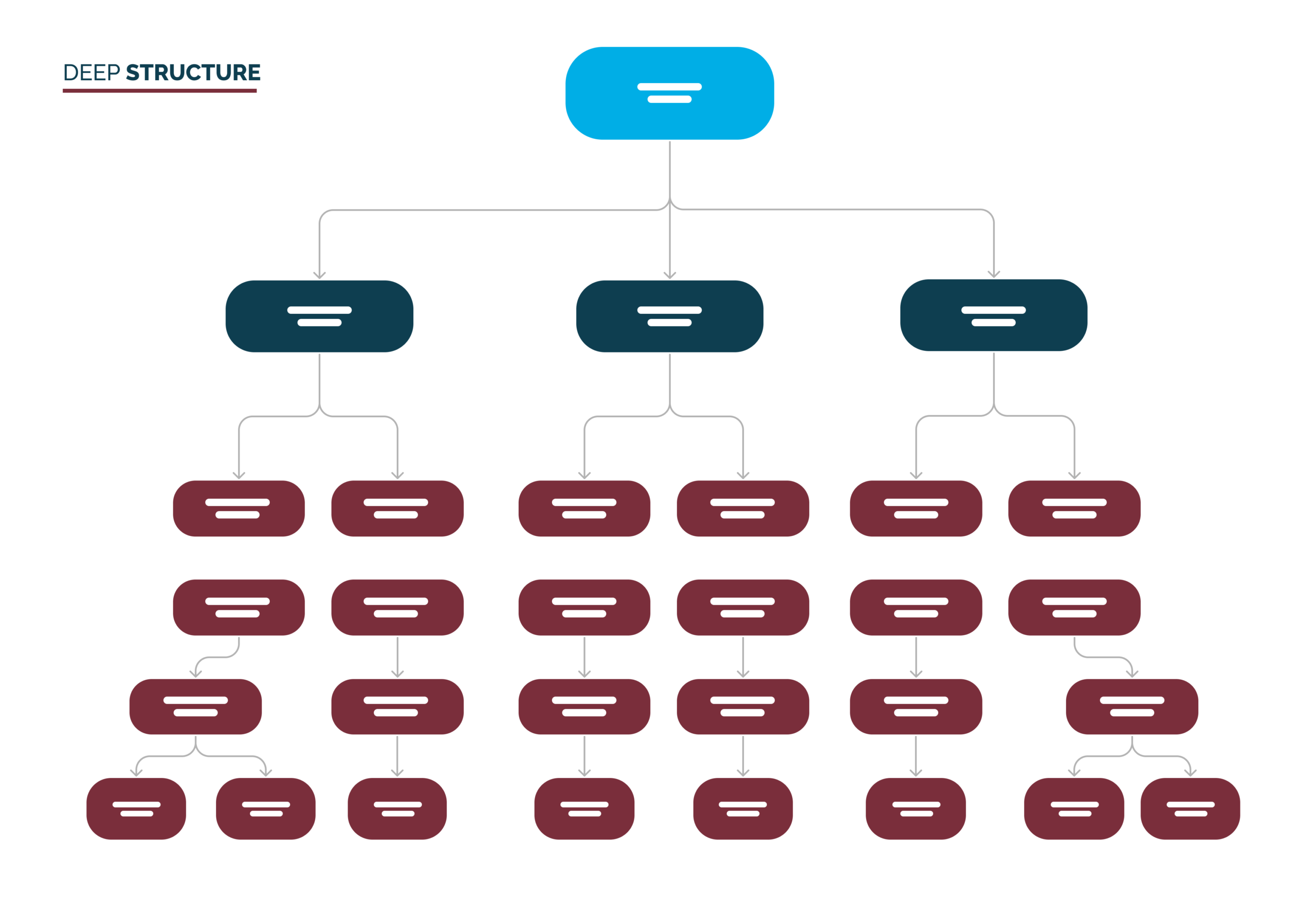
2. Flat Structure:
- Description: A flat structure places all pages at the same level, minimizing subcategories. This layout suits smaller, simpler websites.
- Example URL Structure:
- www.smithlawfirm.com/personal-injury
- www.smithlawfirm.com/car-accidents
- Pros: Simplifies access to information, reducing the need for extensive navigation.
- Cons: Can limit content organization, making it harder to establish clear relationships between topics.
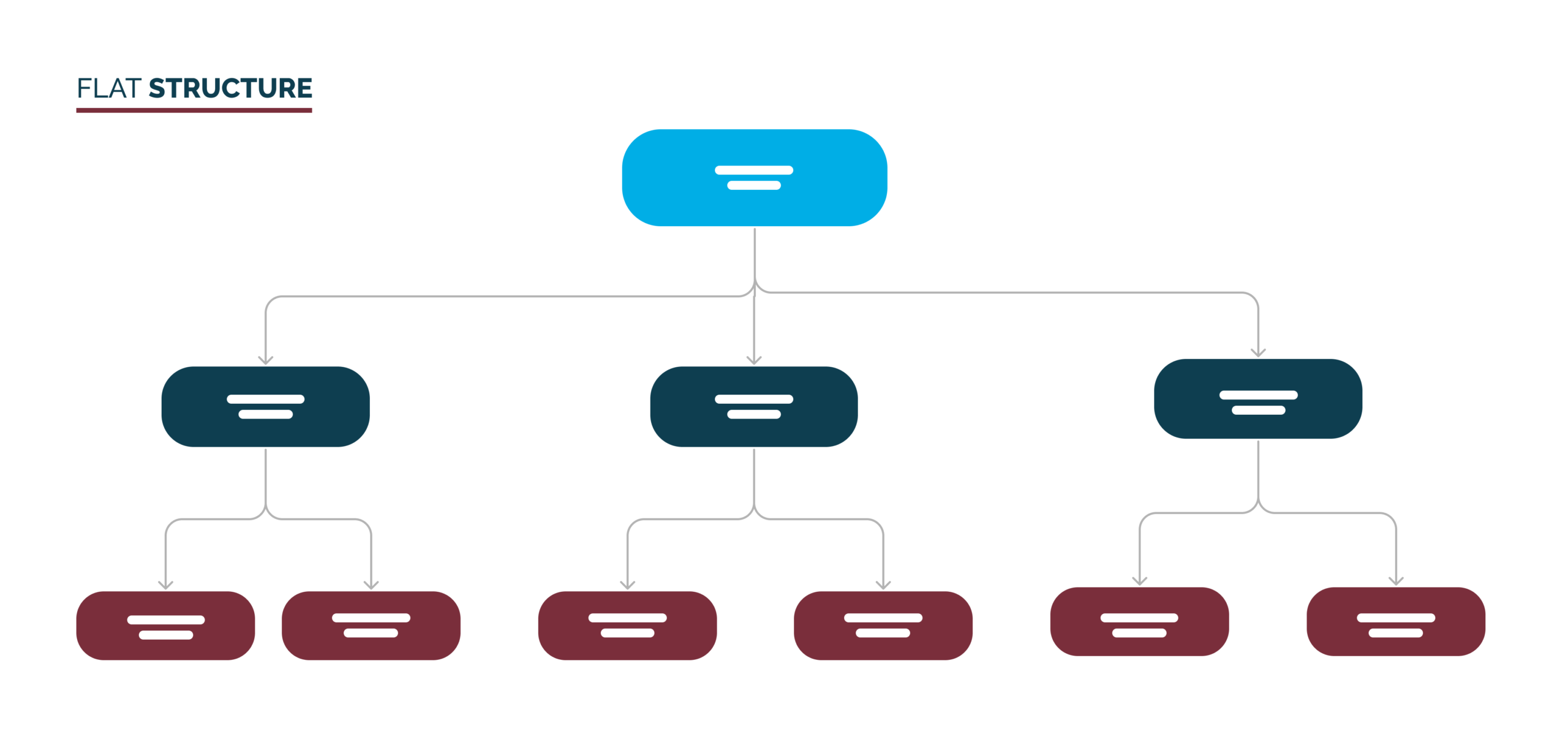
Choosing the Best Structure
The optimal structure depends on the website’s size and content complexity. A hierarchical structure suits larger, content-rich sites, providing clear navigation paths. Flat structures are ideal for smaller sites, prioritizing ease of access over detailed organization.
Hybrid Approach
A hybrid structure combines elements of both, offering a balance. For example, a law firm might have a main page for ‘Practice Areas’ (hierarchical) but list specific services like ‘Divorce’ or ‘Personal Injury’ directly on the main menu (flat).
Managing Multiple Locations
For firms with multiple locations, incorporating location-specific URLs can enhance local SEO. Examples:
- www.smithlawfirm.com/new-york/divorce
- www.smithlawfirm.com/los-angeles/personal-injury
This approach maintains a clean structure while catering to local search needs.
Impact on Site Structure
Incorporating multiple locations requires thoughtful structuring to ensure clarity and ease of navigation. A hierarchical approach often works best, allowing each location to have its dedicated section with specific services listed under it.
In summary, the choice between hierarchical, flat, or hybrid structures should be guided by the specific needs and scale of the website. For multi-location law firms, a hierarchical structure with location-specific subpages often provides the most effective balance of clarity and local SEO optimization.
Title Tags & Meta Descriptions
The Title Tag is an HTML element that specifies the title of a web page. It appears as the main clickable link in search engine results and is displayed at the top of a user’s browser when they visit the page.

Title tags are essential for SEO as search engines use them to understand the content of a page and display relevant results to users. A well-crafted title tag is concise, descriptive, and includes relevant keywords. Here’s what to do :
- Assign each webpage a unique title tag to differentiate content for users and search engines, and to target specific keywords.
- Prioritize target keywords near the start of the title tag, as search engines might emphasize early words more.
- Use relevant keywords in the title tag to clearly define the page content, enhancing search engine understanding and search visibility.
- Ensure the title tag precisely mirrors the page’s content to avoid user dissatisfaction and harm to site credibility.
- Limit title tags to 50-60 characters to prevent truncation and ensure full display in search results.
- Balance keyword inclusion in title tags, aiming for a natural, readable title that delivers value, without keyword stuffing.
- Regularly assess title tag effectiveness with analytics and refine them based on audience response and engagement.
- Incorporate city or state names in title tags for improved local search optimization.
The Meta Description is a brief summary or snippet that describes the content of a web page. While search engines don’t directly use meta descriptions for ranking purposes, they are displayed beneath the title tag in search results. A compelling meta description can encourage users to click through to a page by providing a concise preview of what they can expect. It should be informative, engaging, and relevant to the page’s content.
Here is an example of a well written Meta Description
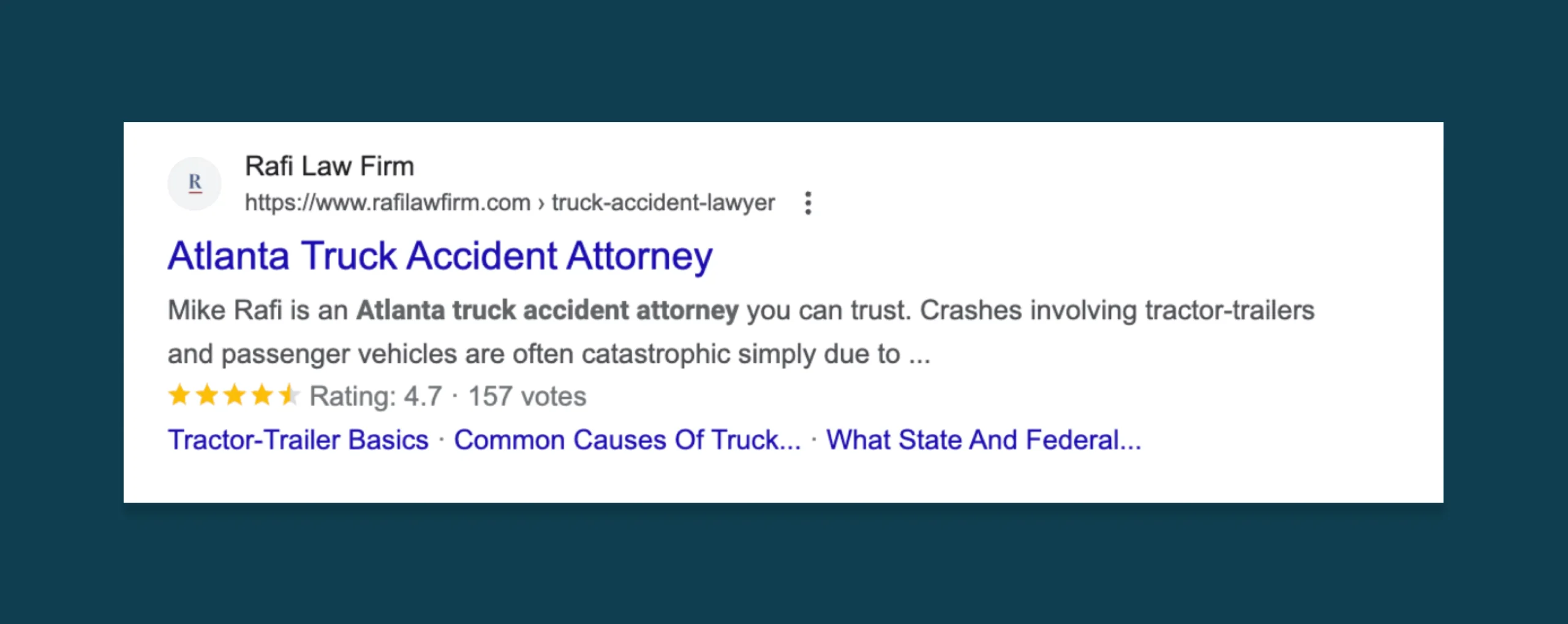
Content
Develop a content strategy that covers a wide range of user intents, from informational to transactional. Incorporate different content types such as videos, infographics, and interactive tools to cater to various user preferences. Regularly review and update your content to ensure accuracy, especially with changing laws and regulations.
Internal Linking

Internal linking refers to the practice of creating hyperlinks that connect one page of a website to another page within the same domain. These links help establish a network of interconnected pages, providing several benefits for both users and search engines.
Key aspects of internal linking in relation to SEO include:
- Navigation and User Experience: Internal links serve as a roadmap for users, guiding them to relevant content within the same website. This improves the overall user experience by making navigation more intuitive and helping visitors discover additional information.
- Distribution of Page Authority: Search engines assign authority or “link juice” to web pages based on the quantity and quality of inbound links. Internal linking helps distribute this authority across various pages within the website, potentially boosting the visibility of interconnected pages in search results.
- Establishing Hierarchy and Relevance: By using descriptive anchor text for internal links, website owners can signal to search engines the hierarchy and thematic relevance of pages. This assists search engines in understanding the structure and content relationships within the site.
- Improved Crawling and Indexing: Internal links provide a pathway for search engine crawlers to navigate and index different pages on a website. This ensures that all relevant content is discovered and included in search engine databases.
- Enhanced Keyword Significance: Anchor text used in internal links can include relevant keywords, contributing to the overall keyword strategy of the website. This can positively impact the ranking of pages for specific terms in search engine results.
- Reduced Bounce Rates: Well-placed internal links can encourage users to explore additional pages, reducing bounce rates. When visitors find relevant and interesting content through internal links, they are more likely to stay on the website for a longer duration.
By incorporating natural, relevant anchor text and constructing a logical link structure, you craft a seamless web of content that effortlessly guides visitors through your site. The use of descriptive anchor text not only sets expectations for users but also adds depth to their browsing experience. Ensuring key content is readily accessible, just a few clicks from the homepage, not only spreads link equity effectively but also elevates the visibility of crucial pages in search results. In essence, strategic internal linking transforms your website into an organized and user-friendly space, optimizing its performance in search engine results.
Site Speed and Performance
Site speed and performance are crucial for SEO due to several interconnected reasons:
- Google considers page speed as a ranking factor. Websites that load quickly are more likely to rank higher in search engine results pages (SERPs), contributing to increased visibility and organic traffic.
- Google’s Core Web Vitals, a set of user-focused metrics, includes page speed elements such as Largest Contentful Paint (LCP) and Cumulative Layout Shift (CLS). Optimizing for these factors improves the overall page experience, positively influencing search rankings.
- Google primarily uses mobile-first indexing, meaning it crawls and indexes the mobile version of websites. A fast-loading mobile site positively impacts search engine rankings for both mobile and desktop searches.
- Slow-loading pages can lead to higher bounce rates. A study by Google revealed that as page load time goes from 1 to 3 seconds, the probability of bounce increases by 32%
- Faster-loading pages are crawled more efficiently by search engine bots. Improved crawl efficiency ensures that search engines can index a larger portion of a website, enhancing its overall visibility in search results.
- Site speed directly influences conversion rates. Users are 3x more likely to convert on sites that load in 1 second.
According to Google, “53% of mobile users abandon a site that takes longer than 3 seconds to load.”
With over 60% of Google’s US organic search traffic originating from mobile devices (Merkleinc, 2019), mobile speed is something you can’t ignore.
Mobile speed directly impacts user satisfaction, search engine rankings, and overall website performance. Prioritizing the optimization of mobile page speed is a strategic move to enhance the online presence and competitiveness of a website in the digital landscape.
You can check your website speed and performance on both mobile and desktop with PageSpeed Insights.
Simply enter in your website’s URL and click “Analyze”. Results will look something like this :
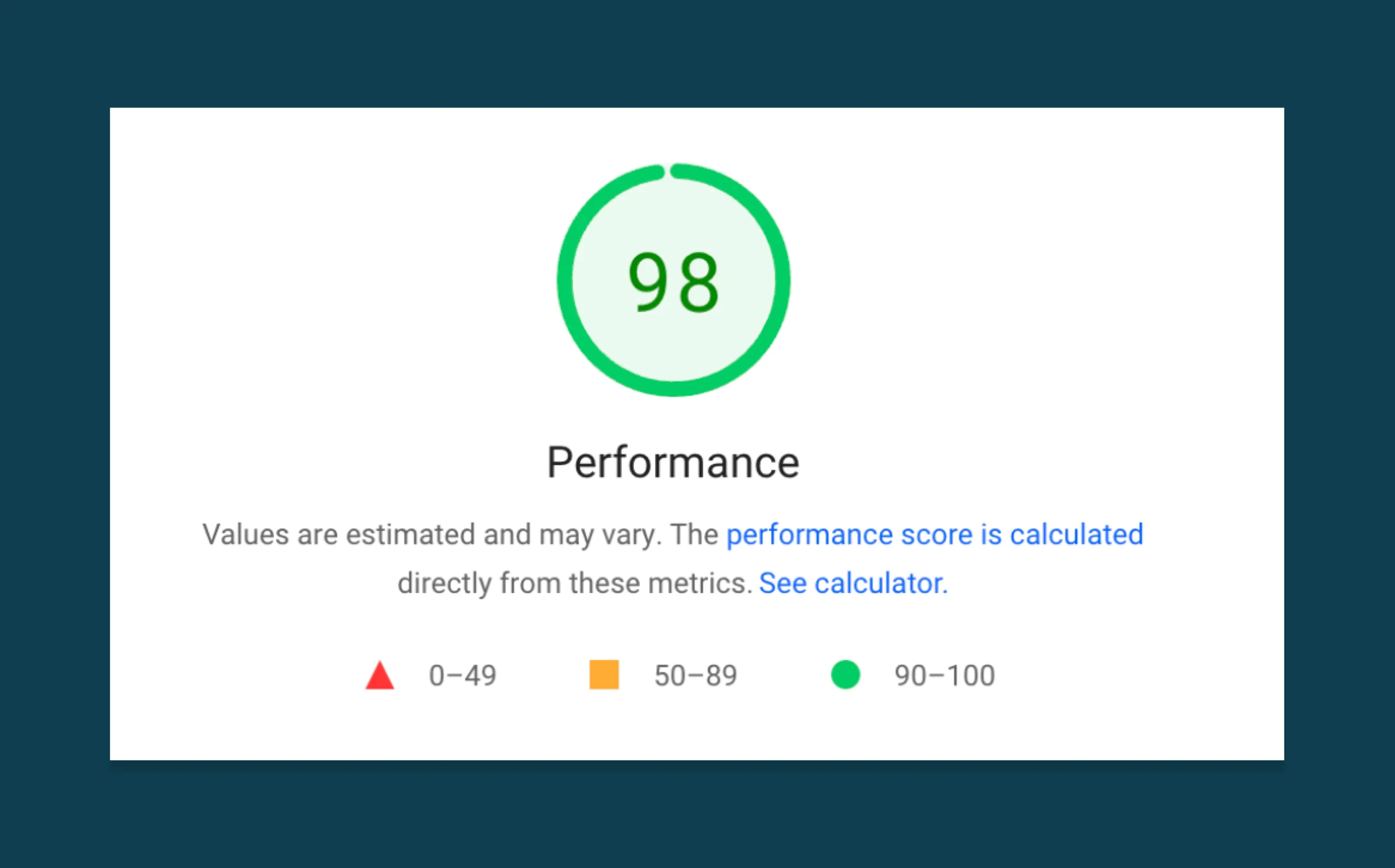
In summary, site speed and performance are integral to SEO success, impacting user satisfaction, search engine rankings, and overall website effectiveness. Prioritizing the optimization of site speed is a strategic move to enhance the online presence and competitiveness of a website.
Enhancing On-Site SEO
- User Engagement Metrics: Monitor metrics like time on page and conversion rates to understand and improve user interaction.
- Mobile Optimization: Ensure your site is optimized for a seamless mobile experience, considering the increasing prevalence of mobile users.
- Accessibility: Make your site accessible to all users, including those with disabilities, to broaden your reach and improve user experience.
- Content Freshness: Regularly update your content to keep it relevant and show search engines that your site is active.
- Structured Data: Utilize schema markups beyond legal schemas to provide search engines with detailed information about your content.
Off-Site SEO for Lawyers
Off-site SEO, also known as off-page SEO, refers to the activities and strategies implemented outside of a website to improve its visibility and ranking in search engine results. While on-site SEO focuses on optimizing elements within a website itself, off-site SEO involves actions taken externally to enhance the site’s credibility, authority, and relevance to search engines.
Here are some key components of Off-Site SEO:
Client Reviews & Legal Directories: The Testaments of Trust
Positive reviews and a strong presence in reputable legal directories are vital.
According to a recent survey by FindLaw, over 60% of consumers would be more likely to hire a lawyer with online reviews.
To expand this strategy:
- Encourage Client Feedback: Implement a system to encourage satisfied clients to leave reviews on platforms like Google, Yelp, and legal-specific directories. Consider follow-up emails or direct conversations after a successful case resolution.Tools such as BirdEye and Podium can help automate this process.
- Respond to Reviews: Actively respond to all reviews, positive or negative, to show that your firm values client feedback and is committed to continual improvement.
- Highlight Reviews on Your Site: Feature positive client testimonials on your website to showcase client satisfaction directly to prospective clients.
- Diversify Directory Presence: Beyond general legal directories, list your firm in niche or practice-specific directories to target a more specific audience.
Social Media Engagement: Building a Community
Active engagement on social media goes beyond posting regular updates. Consider these expanded strategies:
- Interactive Content: Create polls, Q&A sessions, or live videos to foster interaction and engagement from followers.
- User-Generated Content: Encourage clients to share their experiences or participate in discussions, increasing engagement and creating a sense of community.
- Consistent Branding: Ensure your social media profiles are consistently branded with your website, reinforcing your firm’s image and messaging.
Guest Blogging & Community Participation: Sharing Expertise
Guest blogging and participating in legal forums are excellent ways to showcase your expertise. To enhance this strategy:
- Targeted Guest Blogging: Seek out guest blogging opportunities on websites that your potential clients are likely to visit, such as industry news sites, legal advice forums, or business blogs.
- Regular Participation: Become a regular contributor to legal forums or Q&A sites like Quora, establishing yourself as a go-to expert.
- Community Events: Participate in or sponsor local community events and share your experiences and insights on these platforms.
Link Building: Crafting Connections
High-quality backlinks are a testament to your website’s authority. To further this strategy:
- Content-Based Link Building: Create valuable resources like whitepapers, infographics, or detailed guides that other sites naturally want to link to.
- Broken Link Building: Identify broken links on relevant websites and offer your content as a replacement.
- Regular Link Audits: Regularly audit your backlink profile to identify and disavow any low-quality or spammy links.
Influencer Partnerships & PR: Amplifying Your Reach
Collaborating with influencers and leveraging PR can significantly boost your visibility. Consider:
- Legal Influencer Outreach: Partner with legal influencers who can speak to your firm’s strengths and share your content with a broader audience.
- Press Release Optimization: Optimize press releases with relevant keywords and distribute them through platforms used by journalists and potential clients.
- Award Submissions: Regularly submit your firm for legal awards and rankings and share any accolades received through your marketing channels.
Local SEO: Targeting the Community
Local SEO is crucial for law firms serving specific geographic areas. Enhance your local SEO with:
- Localized Content Creation: Create content specific to your location, such as local case studies or guides on local laws, to improve relevance in local search results.
- Community Involvement: Increase your local presence by participating in or sponsoring local events and sharing these experiences online.
- Local Partnership: Partner with other local businesses for joint promotions or events, increasing your visibility and backlinks within the community.
Expanding Your Law Firm's Digital Influence
Expanding and deepening these off-site SEO strategies allows your law firm to build a more authoritative and visible online presence. It’s about creating a multifaceted approach that engages potential clients, establishes your firm’s credibility, and continuously grows your digital footprint. Each strategy, from client reviews to local SEO, should be thoughtfully implemented and regularly monitored to ensure effectiveness. A proactive and comprehensive off-site SEO approach can make all the difference in attracting and retaining clients.
Additional Considerations:
- SEO Audits: Regularly perform SEO audits to identify areas for improvement and ensure your strategies are up to date.
- Competitor Benchmarking: Keep an eye on what competitors are doing and learn from their successes and mistakes.
- Security: Ensure your website is secure, as this is a crucial factor for user trust and search engine rankings.
- Continuous Learning: Stay updated with the latest SEO trends and algorithm updates to keep your strategies effective.
LAW FIRM SEO GUIDE

“Hiring Everspark to do the comprehensive SEO audit of my website was money very well spent. They are thorough, knowledgeable and approachable.”
-Mike Rafi
READY TO PARTNER WITH ONE OF THE BEST DIGITAL MARKETING AGENCIES?
